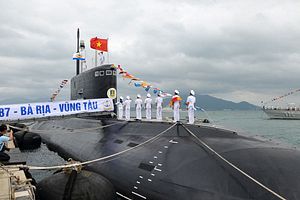The Vietnam People’s Navy (VPN) held a flag raising ceremony for two new Russian-made Project 636M (improved Kilo-class) diesel electric attack submarines at Cam Ranh naval base in Vietnam’s south central coastal Khanh Hoa province on February 28, Vietnam’s Ministry of Defense reports in a press release.
The two submarines — Da Nang and Ba Ria-Vung Tau — will join four other Project 636M boats already in service with the VPN’s Submarine Brigade 189 and are the last two subs commissioned as part of a $ 2.6 billion contract (some sources indicate $2.1 billion) with Russia’s Admiralty Shipyards for six diesel-electric attack submarines in 2009.
The flag raising ceremony was attended by Vietnamese Prime Minister Nguyen Xuan Phuc and other dignitaries. The prime minister emphasized the importance of the VPN in raising awareness over the South China Sea territorial disputes and praised the navy’s willingness to defend every inch of Vietnam including its territorial waters.
He also noted that Vietnam seeks no arms race in the region and the deployment of the new submarines does not aim to deter other countries in the region. Furthermore, he stated Vietnam’s desire for a peaceful solution to the South China Sea disputes. Yet, he was also adamant that Vietnam would defend its sovereignty over its continental shelf, its territorial sea, and its islands.
Project 636M submarines, an improved variant of the original Project 877 (Kilo-class) design, are specifically designed for operations in shallow waters and are primarily intended for anti-shipping and anti-submarine warfare operations. With a crew of 52, the sub has an endurance of 45 days and can reach a submerged top speed of around 20 knots. The Project 636M boats are slightly longer than the original Kilo-class and feature an improved MGK 400E sonar, new noise reduction technology ( the U.S. Navy dubbed the subs “black holes” due to their quietness) and new armaments.
Displacing around 4,000 tons when submerged, the submarines can be armed with both torpedoes and submarines-launched cruise missiles including 3M-14E Klub supersonic cruise missiles, sold to Vietnam by Russia in 2015. As I noted elsewhere: “While it is unknown whether the anti-ship variant of the weapon sold to Vietnam is the 3M-54E Klub-S (range 220km) or 3M-54E1 (range 300km) – both of which can be launched from submarines – the land-attack variant is almost certainly the 3M-14E (range 300km), capable of carrying a 450kg warhead.”
The submarines, armed with supersonic cruise missiles can threaten the People’s Liberation Army Navy (PLAN) naval base at Sanya on China’s Hainan Island as well as Chinese military facilities in the South China Sea. As I explained in June 2016 (See: “US Arms Sales to Vietnam: A Military Analysis”):
Vietnam’s military planning vis-à-vis China is defensive in nature and built around A2/AD—or anti-access and areal denial strategies, exploiting asymmetrical advantages by, for example, fielding new diesel-electric submarines to exploit China’s known weakness in anti-submarine warfare. All of this requires enhanced maritime domain awareness (MDA) and early warning systems in place and the establishment of a so-called kill chain linking “‘see-ers and shooters,’” as one analyst recently put it.
Vietnam’s ultimate goal is to deter China from deploying People’s Liberation Army Navy (PLAN) vessels in so-called gray zone coercion scenarios, which involves the use of China Coast Guard (CCG) and maritime militia vessels to blockade Vietnamese-held islands and features in the South China Sea while avoiding open military conflict.
Whether the VPN’s new submarine fleet will contribute to Vietnam’s overall A2/AD strategy and deterrence capabilities will above all depend on the training of its submarine crews and how well the VPN can maintain the operational readiness of the new boats in the years ahead.






























